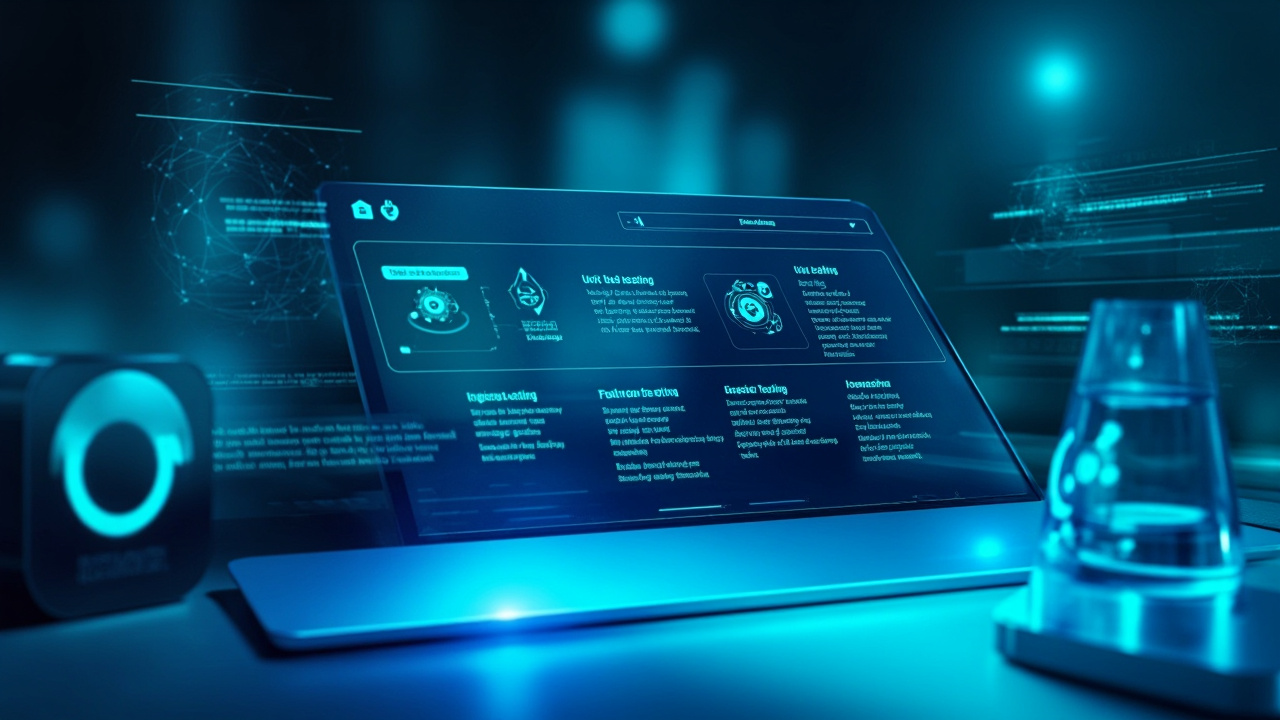In today’s dynamic digital ecosystem, software testing has evolved from a mere checkpoint in the development process to a pivotal component of delivering quality software. As applications become more intricate and interdependent, the pressure on testing teams to ensure robust, error-free software grows exponentially. Traditional methods, while foundational, often fall short in addressing the rapid pace and complexity of modern software development. This is where innovation becomes not just an advantage but a necessity.
Software testing is no longer just about detecting bugs; it’s about ensuring seamless user experiences, maintaining security, and providing scalability. In this article, we will delve into the evolving landscape of software testing, exploring cutting-edge methodologies, tools, and strategies that are shaping the industry. As we navigate through various facets of testing, we will also consider how AI-driven solutions, such as GenQE, are revolutionizing this space by offering unprecedented efficiency and accuracy.
Why should you care about the evolution of software testing? Because it’s not just a technical concern; it’s a business imperative. Software failures can lead to significant losses, both financially and reputationally. Therefore, embracing modern testing solutions is crucial for any organization aiming to stay competitive. This comprehensive exploration will equip you with insights into the latest trends and tools, enabling you to enhance your testing strategies and outcomes.
Understanding the Fundamentals of Software Testing

Software testing is the meticulous process of evaluating a software application to ensure it meets specified requirements and functions correctly. Historically, testing was often seen as a secondary process, executed after development. However, as systems have grown in complexity, the role of testing has expanded to become a continuous, integral part of the software development lifecycle.
The Core Objectives of Testing
At its core, software testing aims to identify defects, ensure quality, and validate that the software meets user needs. The primary objectives include
- Verification and Validation: Ensuring the product behaves as expected and fulfills the intended requirements. This objective is critical in industries like healthcare and finance, where errors can lead to severe consequences.
- Defect Detection: Identifying bugs and issues that could impact the user experience. With the rise of user-centric applications, even minor defects can lead to user dissatisfaction.
- Quality Assurance: Maintaining a high standard of software quality through rigorous testing processes. This involves a combination of automated and manual testing to cover all bases.
“Testing is not about proving the absence of bugs; it’s about finding them before the user does.”
Types of Testing
Testing can be broadly categorized into several types
- Unit Testing: Focuses on individual components or functions of the software. For instance, testing a single function in a codebase to ensure it returns the expected output. Integration Testing: Examines the interaction between integrated modules, ensuring that combined components function together as intended. System Testing: Evaluates the complete system as a whole, assessing the end-to-end functionalities of an application. Acceptance Testing: Ensures the software meets the business requirements and is ready for delivery. This is often the final testing phase before a product goes live.
These testing types form the backbone of a robust testing strategy, each serving a distinct purpose in the validation process. For example, a recent study by the Institute of Electrical and Electronics Engineers (IEEE) highlighted that projects employing a balanced mix of these testing types reported a 30% decrease in post-release defects.
The Challenges Facing Traditional Testing Methods

Despite their importance, traditional testing methods often encounter significant challenges that can hinder their effectiveness. These challenges underscore the need for innovative solutions in the testing landscape.
Scalability and Complexity
As software systems become more complex, testing them comprehensively becomes increasingly difficult. Traditional methods struggle to scale efficiently, leading to incomplete test coverage and missed defects. The rise of microservices architecture, for instance, introduces interdependencies that must be meticulously tested. This complexity was evident in a case where a missed integration test in a microservices environment caused a significant financial services outage, highlighting the dire need for robust testing strategies.
Time Constraints
The pressure to deliver software quickly means testing windows are often compressed. This can lead to rushed testing efforts, where critical defects might slip through the cracks. The need for speed in testing without compromising quality is one of the most pressing challenges today. For example, a survey by the World Quality Report indicated that 40% of organizations cite time constraints as a major barrier to effective testing.
“Inadequate testing is a choice that many companies inadvertently make due to time constraints, but it often leads to costly consequences.”
Resource Limitations
Testing requires skilled resources, both in terms of personnel and technology. However, many organizations face resource limitations, resulting in insufficient testing efforts. This is where AI-driven tools like GenQE can offer significant advantages by automating labor-intensive tasks and optimizing resource allocation. By reducing manual efforts, teams can focus on more strategic testing activities.
Innovations in Software Testing: The Role of AI and Machine Learning

The integration of AI and machine learning into software testing marks a paradigm shift, offering solutions to many traditional challenges. These technologies bring automation, intelligence, and adaptability, transforming how testing is conducted.
AI-Driven Test Automation
AI-driven test automation is reshaping the testing landscape by automating repetitive tasks, thus freeing up human testers to focus on more complex issues. This automation enhances efficiency and consistency, leading to faster and more reliable testing cycles. A study by Forrester Research found that organizations using AI-driven test automation reported a 50% reduction in testing times.
GenQE, for instance, utilizes AI to generate and execute test cases automatically, ensuring comprehensive coverage while minimizing manual effort. By analyzing software requirements and historical data, GenQE predicts potential defects, allowing teams to preemptively address them. This proactive approach significantly reduces the number of defects reaching production.
Enhancing Test Accuracy
Machine learning algorithms can analyze vast amounts of data to identify patterns and anomalies that might be missed by human testers. This capability enhances the accuracy of defect detection and reduces false positives, leading to more reliable testing outcomes. For example, a tech giant incorporated machine learning into their testing process and achieved a 30% increase in defect detection accuracy.
“AI doesn’t replace human testers; it augments their capabilities, allowing them to focus on higher-level testing activities.”
Adaptability and Self-Healing Scripts
In dynamic environments where software changes frequently, maintaining test scripts can be cumbersome. AI-driven solutions offer self-healing capabilities, where test scripts automatically adapt to changes in the application, minimizing maintenance efforts. This adaptability is crucial in agile environments, where changes are frequent and rapid.
Best Practices for Implementing Modern Testing Strategies

To effectively adopt modern testing strategies, organizations must align their processes with best practices that leverage the strengths of AI and other innovative technologies.
Embrace Continuous Testing
Continuous testing integrates testing into the development process, ensuring that testing is conducted at every stage of the development lifecycle. This approach allows for early detection of defects and reduces the risk of late-cycle surprises. A comprehensive review by Gartner showed that continuous testing can reduce time to market by up to 60%.
Incorporating tools like GenQE can further enhance continuous testing by automating various testing stages, ensuring that tests are executed consistently and efficiently. This integration also allows for real-time feedback, enabling developers to address issues immediately.
Prioritize Risk-Based Testing
Risk-based testing focuses on identifying and prioritizing the most critical areas of the application. By assessing the potential impact and likelihood of defects, teams can allocate resources more effectively, concentrating efforts where they matter most. This strategic approach ensures that high-risk areas receive adequate attention, reducing the likelihood of critical failures.
“Testing everything is impractical; testing the right things is essential.”
Invest in Training and Skill Development
While tools like GenQE automate many aspects of testing, human expertise remains irreplaceable. Investing in continuous training ensures that teams stay updated with the latest testing methodologies and technologies. Organizations that prioritize training often see improvements in testing efficiency and effectiveness, as skilled testers can better utilize advanced tools and techniques.
The Impact of AI on Developer Productivity and Software Quality

AI’s influence extends beyond testing, significantly impacting developer productivity and overall software quality. By streamlining testing processes, AI allows developers to focus on innovation and feature development.
Reducing the Burden of Repetitive Tasks
AI solutions automate routine tasks such as test case execution, data entry, and defect tracking. This automation reduces the workload on developers, allowing them to dedicate more time to creative and strategic activities. A report by McKinsey & Company highlighted that automating repetitive tasks can improve developer productivity by up to 30%.
Accelerating Time to Market
With faster and more efficient testing processes, organizations can accelerate their release cycles. This speed-to-market advantage is crucial in competitive industries where timeliness can be a differentiator. Companies that have adopted AI-driven testing have reported a significant improvement in their ability to meet market demands promptly.
Enhancing Collaboration and Communication
AI-driven analytics provide valuable insights into software quality, enabling better communication between development and QA teams. This collaboration fosters a culture of continuous improvement and quality assurance. For instance, a leading tech firm implemented AI analytics to streamline communication between teams, resulting in a 20% reduction in defect resolution time.
Case Studies: Real-World Applications and Success Stories

Exploring real-world applications of innovative testing solutions provides valuable insights into their practical benefits and challenges.
Case Study 1: A Financial Institution’s Journey to Quality Assurance
A leading financial institution faced challenges in maintaining software quality due to complex regulatory requirements and a rapidly evolving digital landscape. By integrating GenQE into their testing process, they achieved significant improvements in test coverage and defect detection accuracy, reducing their release cycle time by 30%. This integration allowed the institution to meet stringent regulatory standards and improve customer satisfaction.
Case Study 2: Enhancing User Experience in E-commerce
An e-commerce giant leveraged AI-driven testing to enhance user experience across multiple platforms. The implementation of smart test execution and self-healing scripts led to a 40% reduction in customer-reported issues, significantly boosting customer satisfaction. This case underscores the importance of AI in maintaining a seamless user experience in a highly competitive market.
Lessons Learned
These case studies highlight the importance of strategic tool integration and the tangible benefits of AI-driven testing in enhancing software quality and operational efficiency. By adopting AI-driven solutions, organizations can achieve significant improvements in various aspects of their software development lifecycle.
Conclusion: Embracing the Future of Software Testing

The evolution of software testing is not just a technological advancement; it’s a fundamental shift in how we approach quality assurance. As we’ve explored, the integration of AI and machine learning offers transformative potential, addressing traditional challenges and paving the way for more efficient, accurate, and adaptive testing processes.
GenQE exemplifies how innovative solutions can enhance testing strategies, but it’s crucial to view AI as part of a broader toolkit. By embracing modern testing practices and leveraging the strengths of AI-driven tools, organizations can ensure their software meets the highest standards of quality and reliability.
“The future of software testing lies in our ability to adapt, innovate, and embrace change.”
As you consider the testing strategies that best suit your organization, explore the potential of AI-driven tools to transform your processes and outcomes. By doing so, you’ll not only enhance your testing capabilities but also position your organization for success in an ever-evolving digital landscape.
Call to Action: Ready to take your software testing to the next level? Explore how AI-driven solutions like GenQE can revolutionize your testing processes and drive quality improvements. Embrace innovation, enhance efficiency, and ensure your software meets the demands of the modern world.
Discover More Innovative Solutions
Want to learn more about the tools and technologies discussed in this article? Explore how these innovations can be tailored to your specific needs and workflow requirements.
Our team of experts is available to answer your questions and provide personalized insights into how modern solutions like GenQE can address your specific challenges.
If the link above does not work, please visit: https://calendly.com/dm-csimplifyit/30min?month=2025-05